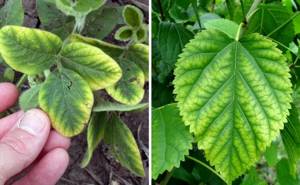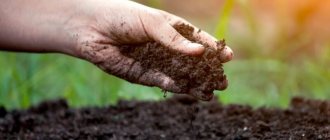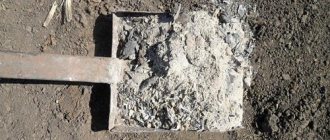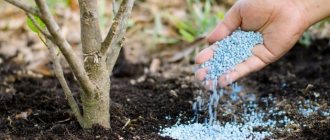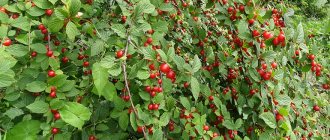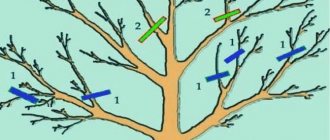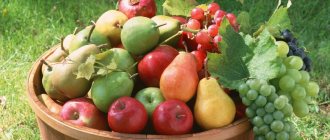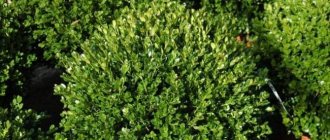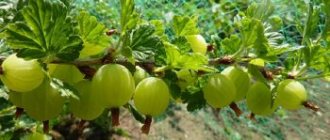Thanks to fertilizing the site in the spring, plants grow quickly, develop fully, and the soil is fully saturated with nutrients.
The main thing is the proper use of nutrients. You should not follow the principle “the more the merrier.” An excess of any fertilizer can lead to the opposite effect - stunting, soreness, reduced growth of garden crops and the delayed appearance of fruits of not the best quality.
When to start spring soil fertilization
Early spring on snow
When the snow begins to melt, fertilizers are spread over it. This is the fastest and easiest way to feed, but not the most effective; it is practically of no use. After all, most of the nutrients are washed away by melt water.
When preparing the soil for sowing
This is perhaps the most effective method that provides maximum benefit. After applying fertilizer, which penetrates deep into the soil, to the level of the root system, it is best to cover it with a layer of soil.
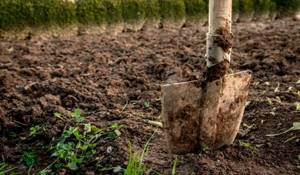
During sowing and planting
The most difficult and risky method, because... there is a high probability of making mistakes associated with incorrect application rates of nutrients. If you have modern agricultural machinery, then this application of fertilizers will be beneficial. It is better not to apply fertilizers manually.
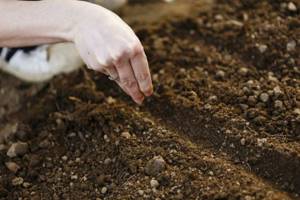
How to fertilize the soil for potatoes if there is no manure?
We offer several options for replacing fertilizing the soil with cow manure
1. a bucket of humus, 20 grams of ammonium nitrate, 20 grams of potassium sulfate, 40 grams of superphosphate, 450 grams of dolomite flour per 1 square meter.
2. a bucket of compost, 30 grams of nitrophoska, 20 grams of potassium sulfate, 20 grams of ammonium nitrate per 1 square meter.
3. 1 bucket of humus, 3 tablespoons of nitrophoska, 1 glass of ash per 1 square meter.
4. If green manure grows on the site, then along with planting the green mass it is enough to add 20 grams of ammonium nitrate, 20 grams of potassium sulfate per 1 square meter.
5. If there is a deficiency of organic matter, complex fertilizers are applied: nitrophoska at the rate of 5 kilograms per hundred square meters or nitroammophoska (3 kilograms per hundred square meters).
Types of fertilizers for spring application
Organic fertilizers
Organic matter feeds plants, saturating them with useful elements, improves soil structure, and increases the number of beneficial bacteria.
But you should be careful with organic fertilizers - some of them may contain weed seeds, fungal spores, eggs or larvae of pests.
Let's look at the most popular types of organic fertilizers:
- humus
in the spring before preparing the soil for sowing, and then be sure to cover it, otherwise the bulk of the beneficial organic substances will be lost. - Peat
has the same timing and application technology as humus, but this fertilizer must be used very carefully. Some manufacturers sell peat with high acidity, which significantly reduces yields and harms the soil. - , bird droppings
must be diluted with water, because This is a very aggressive fertilizer, and the slightest excess of the dose can cause great harm to the plants. It is recommended to water the plants in the spring after planting and during feeding. - Compost
, like humus, is a valuable, universal fertilizer that must be prepared in compliance with agricultural technology. Compost is applied in the spring when preparing the soil for planting. - Ash
is a fertilizer, the exact amount of which may not be observed, because... Plants use only the amount of nutrients they need from it. Ash can only be used in calm weather. Ash can also be sprinkled on the snow in the spring, this will help the soil warm up more quickly. - Earthworms
are the most effective and environmentally friendly fertilizer. Worms should be introduced in the spring, when the soil at a depth of 10-15 cm has warmed up to +12 degrees. Thanks to worms, the acidity in the soil is normalized, it becomes looser, enriched with useful microelements and saturated with oxygen. - Sapropel
consists of organic sediments of water bodies. It is recommended to apply sapropel in the spring before preparing the soil and during sowing. After application, be sure to cover with earth. - Bacterial fertilizers
(nitragin, azobacterin, phosphobacterin) are the same humus, only in concentrated form. Such fertilizers should be applied in the spring during sowing. They help increase biochemical processes and improve plant nutrition.
Mineral fertilizers
Mineral fertilizers, unlike organic matter, do not improve the structure of the soil, but they improve the health and saturate plants with useful substances that they need at a specific stage of development,
Basically, all mineral fertilizers are sold in the form of granules, which is very convenient to use - in early spring they are scattered on the surface of the earth before digging or planting.
Types of mineral fertilizers
- Nitrogen
helps increase the green mass of plants (used in increased doses for cabbage, salads and other greens); - Phosphorus
increases the number and size of fruits (higher doses can be used for cereals, strawberries, peas, etc.); - Potassium
promotes better development of the root system (the application rate is increased for carrots, potatoes, beets and other root vegetables).
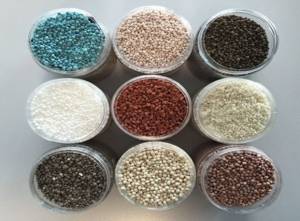
Mineral fertilizers must be applied every year in the following proportions:
- Phosphorus (ammophos, superphosphate): 25 grams per 1 m2.
- Nitrogen (urea, ammonium nitrate): 30-35 grams per 1 m2.
- Potash (kalimag, potassium sulfate, potassium magnesia): 20 grams per 1 m2.
It is very important to correctly calculate the dosage or carefully follow the manufacturers’ recommendations, and before applying mineral fertilizers it is recommended to do a chemical analysis of the soil.
Improper use of fertilizers can harm plants. And if it is not necessary to monitor the dose of potassium, because... plants themselves will not consume excess microelements, then the correct dosage of nitrogen is very important - plants do not control its consumption, their leaves can become dark green, very large and unsuitable for consumption.
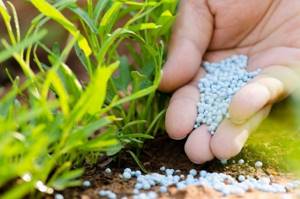
Complex fertilizers
Complex fertilizers make it easier to care for plants, help accelerate their growth and increase productivity. Such preparations are made into several types depending on the planting: for flowers, grains, pumpkins, fruit trees, nightshades, lawns, etc. In addition, the use of complex fertilizers reduces the frequency of fertilizing.
Complex fertilizers are applied before planting during soil preparation or as a top dressing during the period of plant growth and development.
The most popular complex fertilizers: “Stimul”, “Aquarin”, “Ammophos”, “Azofoska”, “Kalimagnesia”, “Plantafol”, “Kemira”, “Kristalon”, “Signor Tomato”, “Kalimag”.
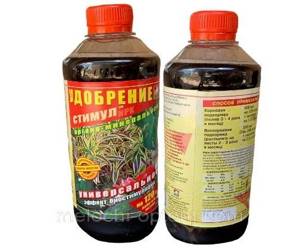
Traditional methods of feeding
- Bone meal and eggshells enrich the soil with calcium and contribute to its deoxidation. For greater efficiency, fertilizing is embedded in the substrate;
- Onion peels disinfect the soil and help get rid of pests;
- Green manures (rye, oats, mustard, oilseed radish, rapeseed, clover) enrich the soil with nitrogen;
- Sawdust and bark enrich the soil with nitrogen, making it looser and softer;
- Silt collects in lakes or ponds. Compared to manure, it contains 4 times more nitrogen.
Other Manure Replacement Options
There are different alternative types of organic fertilizers. Sapropel (river silt) showed good results when used. You can buy it ready-made or collect it yourself in the fall, leaving it in a heap for the winter. The substance can be added to compost fertilizer.
Another option is feeding from peat (a bucket) and ash (a half-liter jar), laid out in layers. This mixture has optimal acidity and increases fertility.
Thus, manure in the garden can be replaced with any other organic fertilizer: vermicompost, compost, liquid manure, as well as specially developed and commercially produced preparations with a similar effect.
Signs of lack of fertilizer
Nitrogen
- Pale leaves of root vegetables and tuberous vegetables have a yellowish or pinkish tint;
- The plant grows and develops slowly;
- Small, deformed, falling leaves.
Phosphorus
- Purple or bluish color of the tops;
- Some plant leaves curl upward.
Potassium
- The appearance of burns along the edges of the sheets;
- The greenery becomes deformed (it begins to curl downwards);
- When flowering, the buds dry out and fall off;
- Fruits are not formed.
Magnesium
- The leaves begin to turn yellow at the edges and bend inward (the reason may be the frequent application of potassium fertilizers to the soil).
Copper
- The tips of the leaves begin to turn white or silver;
- Plants are affected by chlorosis;
- Mature leaves quickly wither and fall off.
Zinc
- Uneven plant growth;
- The upper leaves of low-growing plants become covered with brown spots.
- The appearance of chlorotic veins near the base of young leaves
If you determine which element your soil is lacking, it is best to use complex fertilizers.
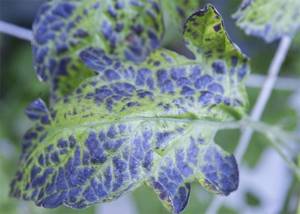
What and how to fertilize fruit trees in spring?
I think that in every garden nowadays there are fruit trees - favorite varieties of apple and pear trees, peaches or apricots, cherries, sweet cherries or plums. Each of them really needs the right conditions for healthy growth and fruiting. In spring, our garden especially needs proper fertilizing with high-quality fertilizers.
The first feedings are carried out even before the appearance of young foliage. Mineral fertilizers with superphosphate and nitrogen are suitable for this. Fertilizers with phosphorus should be applied at the very beginning of spring, as it is slowly absorbed by plants, so the end of March is a good time.
At the next stage, when the earth has probably already thawed and warmed up a little, you can use organic fertilizers. Regardless of what kind of organic matter you decide to feed fruit trees with, you first need to loosen the soil around the perimeter of the trunk circle and add humus, ash, prefabricated mixtures or aqueous nutrient solutions into the resulting “groove” along its outline, up to 15 centimeters deep, not forgetting This means that it is through the peripheral root system that the tree feeds.
At the end of April or May, when fruit trees are flowering, we need to help the plant form a large number of healthy ovaries, because this determines how good a harvest we will get from our garden. And complex fertilizers with an increased proportion of potassium content are suitable for this. Don’t forget to spray the trees on time and protect them from diseases and pests.
Signs of overfertilization
Nitrogen
- The plants look too powerful and overfed, have a massive stem and dark green tops;
- The period of plant growth and development increases;
- The quality of the fruit deteriorates;
- In tomatoes, the leaves curl and become affected by chlorosis, and the petioles bend;
- In cucumbers, old leaves become deformed and become covered with transparent spots, which subsequently become yellow or gray-brown;
- Fruits accumulate nitrates.
Phosphorus
- Leaves become spotted, turn yellow and fall off;
- Plants quickly age and wither;
- The tips of old tomato leaves turn yellow or brown.
Potassium
- Internodes are too long;
- Leaves become too light;
- Plants grow worse and slower;
Magnesium
- The leaves take on a black-green hue and begin to curl;
- In tomatoes, the tops become smaller, the ends of the leaves lengthen and die.
Calcium
- Rapid growth of shoots that also quickly wither.
- The leaves are affected by interveinal chlorosis with pale spots in the form of circles, which can sometimes be filled with liquid.
